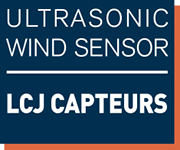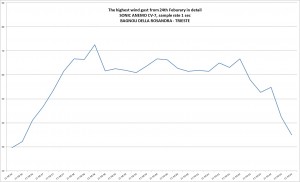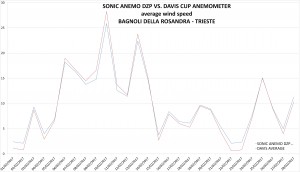27 Mar Feelings of the SONIC-ANEMO-DZP by Darko Bradassi
The first impression of the SONIC ANEMO DZP is very good. It’s more accurate, sensitive and responsive, as shown in the graphs, than the ever valid Davis cup anemometer. But as you probably know, sonic anemometers are another story.
The first graph shows the data of one normal episode of the wind bora, nearby the Gulf of Trieste, in the locality of Bagnoli della Rosandra – Boljunec (Trieste)
.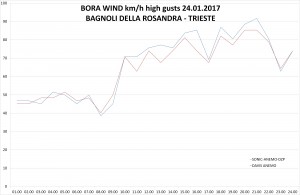
The SONIC ANEMO DZP in that situation was better for measuring highest bora gusts than the Davis cup anemometer. The wind bora is very complicated to measure with precision, because it is very turbulent and not linear, especially at high speed. The highest bora gusts are very short, they last about one second or less. So for measuring them you need a very responsive anemometer. As you can see, the SONIC ANEMO DZP measured the highest wind gust of 91,7 km/h and the Davis cup anemometer of 85,3 km/h. The difference is about +7% in favor of the SONIC ANEMO DZP. The average value of the highest wind gusts from 10.00 to 22.00 is 79,7 km/h for the SONIC ANEMO DZP and 75,4 km/h for the Davis cup anemometer, the average difference is +5,4% in favor of the SONIC ANEMO DZP.
Please note that the cups anemometers have frequently a well known “overspeeding error” and the DAVIS also has a software correction to compensate a supposed loss of speed for different wind angles (this is the reason that with the Davis cup anemometer you have to choose and set the cup size in the WeatherLink software to large or small. Only the option “Vue or other” is without correction, this is ok for the SONIC ANEMO DZP!). So, the differences would probably be greater.
In the second graph you can see the highest wind gusts in February with different winds and different intensity. The values between the SONIC ANEMO DZP and Davis cup anemometer are quite similar, but there are also some exceptions. On the 9th of February (dominant wind of bora) and on the 18th of February (dominant wind from SW) the SONIC ANEMO DZP measured the highest gust of 70,8 km/h and
the Davis cup anemometer of 64,4 km/h. So the difference was about +9% in favor of the SONIC ANEMO DZP.
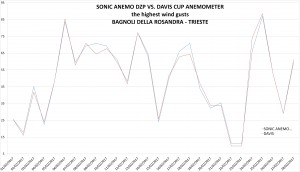
On the 24th of February the Davis cup anemometer measured the highest gust of 74,0 km/h and the SONIC ANEMO DZP of 66,0 km/h. The difference was about +11% in favor of the Davis cup anemometer. It seemed very strange, so we took the data from the extremely reactive SONIC ANEMO CV-7 E (4 Hz, sample rate 1 sec) for a comparison.
As you can see in the graph, the CV-7 E measured the highest, very short gust (lasted only about 0,25 sec) 72,6 km/h and a lot of short gusts (lasted about 0,25 sec) of 66 km/h or less. So the data of 74 km/h, measured from the Davis cup anemometer, is not really. Don’t forget, that the Davis cup anemometer measures the average wind speed of 2,25 seconds, so it is impossible, that the average speed of the Davis could be higher than an istantaneous measurement of the CV-7 E.
On the graph you can also see the strong wind acceleration from 30 km/h to more than 70 km/h in 2 seconds. So probably the software correction of the Davis cup anemometer is gone overboard and maybe there was also an overspeeding error.
The SONIC ANEMO DZP is more reactive and accurate than the Davis cup anemometer, it hasn’t typical overspeed errors of cup anemometers and don’t need software corrections, which can, as we can see in the graphs, sometimes influence the data.
The last graph illustrates the average wind speed in February.
The measurements of average wind speed over 10-15 km/h were higher with the Davis cup anemometer, the measurements of wind speed under 10-15 km/h were higher with the SONIC ANEMO DZP. In the first case the data of the Davis cup anemometer were probably conditioned in particullary from the cup anemometers overspeed error. In the other way the measurements of winds under 10-15 km/h were much better with the SONIC ANEMO DZP, which is noticeably more sensible with very slight wind.
Darko Bradassi, meteorologist and journalist, dbradas@gmail.com
